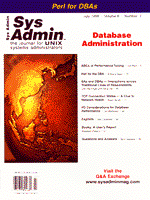
Books: A User's Report
Elizabeth Zinkann In this issue, two mini-reviews on networking and network management lead the column, followed by reviews of a Solaris book, a Perl and CGI selection, and a preventative injury offering. The reviewed books are: Ethernet Networks, Third Edition by Gilbert Held (John Wiley & Sons, Inc.); SNMP, SNMPv2, SNMPv3, and RMON 1 and 2, Third Edition by William Stallings (Addison-Wesley); A Practical Guide to Solaris by Mark G. Sobell (Addison Wesley Longman); Perl and CGI for The World Wide Web: Visual QuickStart Guide by Elizabeth Castro (Peachpit Press); and ErgAerobics: Why Does Working @ My Computer Hurt So Much? by Perry Bonomo and Daniel Seidler (ErgAerobics, Inc.). (Note: The review of Sobell's Solaris book was done prior to its publication, using a draft manuscript. The final book may include some changes.)
Ethernet Networks
SNMP, SNMPv2, SNMPv3, and RMON 1 and 2 Stallings presents an Introduction, the elementary concepts of Networking Management, details the features of SNMPv1, RMON, RMON2, SNMPv2, SNMPv3, and includes appendices pertaining to the TCP/IP Protocol Suite and Abstract Syntax Notation One (ASN.1). The modifications and changes in the third edition highlight SNMPv3, its attributes, and particularly its cryptography features. Stallings discusses the essential concepts and their practical applications logically and thoroughly. This is an indispensable and excellent guidebook and resource for everyone involved with network management or administration.
A Practical Guide to Solaris Many elusive details of the Solaris operating system (particularly the 2.7 release) are examined and illustrated. Administrators with experience in different systems will discover information relevant to their specific expertise. For example, users who have exposure primarily to UNIX System V may notice different command names for familiar tasks, depending on their particular Solaris system's configuration. The systems administrator familiar with UNIX System V will discern some differences, but will recognize most commands and procedures. The UNIX Utility Programs are listed by function in an introductory table; they appear in alphabetical order. Sobell also employs a sample page layout to demonstrate how the utility entries are formatted. A Practical Guide to Solaris is an effective and thorough means to learn how to use or administer a Solaris system. The author demonstrates the aspects and capabilities of Solaris through its options and possible configurations. He reviews various windowing alternatives, SCCS (Source Code Control System), daily system operations, processes, encryption, POSIX Standards, networking, shell programming, email, and employs tutorials when applicable. A Practical Guide to Solaris is an outstanding book, providing a comprehensive study of the advantages and qualities of Solaris 2.
Perl and CGI for The World Wide Web: Visual QuickStart Guide
So what does it mean to program, anyway? Is it dangerous? ... Following the realistic conclusion that programming is not dangerous and that this book can safely be used by a novice, the author presents the opening topics: Perl Building Blocks, Creating Perl CGI Scripts, Getting Data From Visitors, Environment Variables, and Getting Data into the Script. Castro continues with Working with Scalars, Working with Arrays, Conditional Statements, Subroutines, Working with Hashes, Analyzing Data, Remembering What Your Visitors Tell You, Printing and HTML, Files and Directories, Debugging, and Using Other Folks' Scripts. The Appendices contain: A) Parsing Form Input, B) Permissions, C) Security, D) UNIX Essentials, and E) Perl and CGI Resources, succeeded by an extremely complete Index. Castro demonstrates a superior approach to the topics combined with a skillful writing style. Each chapter divides the respective subject into smaller segments, which are easy to comprehend. The Visual QuickStart Series provides illustration and written descriptions next to each other. This method permits the reader to envision the procedures and the results as the author discusses it. Perl and CGI For The World Wide Web: Visual QuickStart Guide is an excellent book. Elizabeth Castro explains each concept thoroughly and clearly illustrates how the reader can implement it. This is a perfect book for a beginning programmer or for an experienced programmer who needs a quick review. The techniques are well presented, and the book may later be utilized as a reference guide. I often recommend books in this series for professionals who need the skills and knowledge immediately, if not sooner. The books also furnish excellent guides for anyone who normally has difficulty learning a new language. Perl and CGI For The World Wide Web is an outstanding learning tool, a valuable reference, and a superb book.
ErgAerobics: Why Does Working @ My Computer Hurt So Much? Bonomo and Seidler explain the injuries clearly and present unobtrusive and brief exercises. Most can be completed without creating a major (or minor) interruption or appearing conspicuous. The book examines most of the aches and pains computer users experience, with or without a computer. ErgAerobics also offers a videotape ($14.95), which demonstrates 42 of the exercises and an 8" x 17"-poster ($3.95) illustrating eight of the most useful exercises to display within a workstation's view. ErgAerobics: Why Does Working @ My Computer Hurt So Much? provides an excellent way to relieve some of the stress and tension associated with any repetitive activity and highlights the problems connected with continued computer use.
About the Author
Elizabeth Zinkann has been involved in the UNIX and C environment for the past 12 years. She is currently a UNIX and C consultant, and one of her specialties is UNIX education. In addition to her computer science background, she also has a degree in English. Elizabeth can be reached via America Online (ezinkann@aol.com).
|